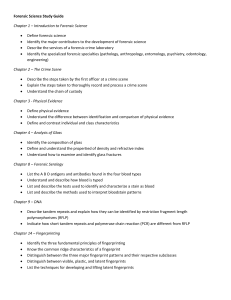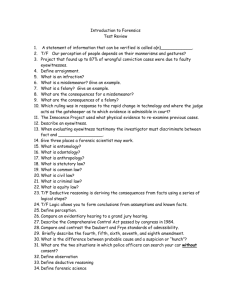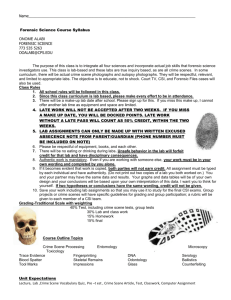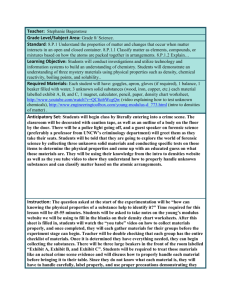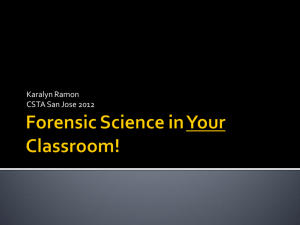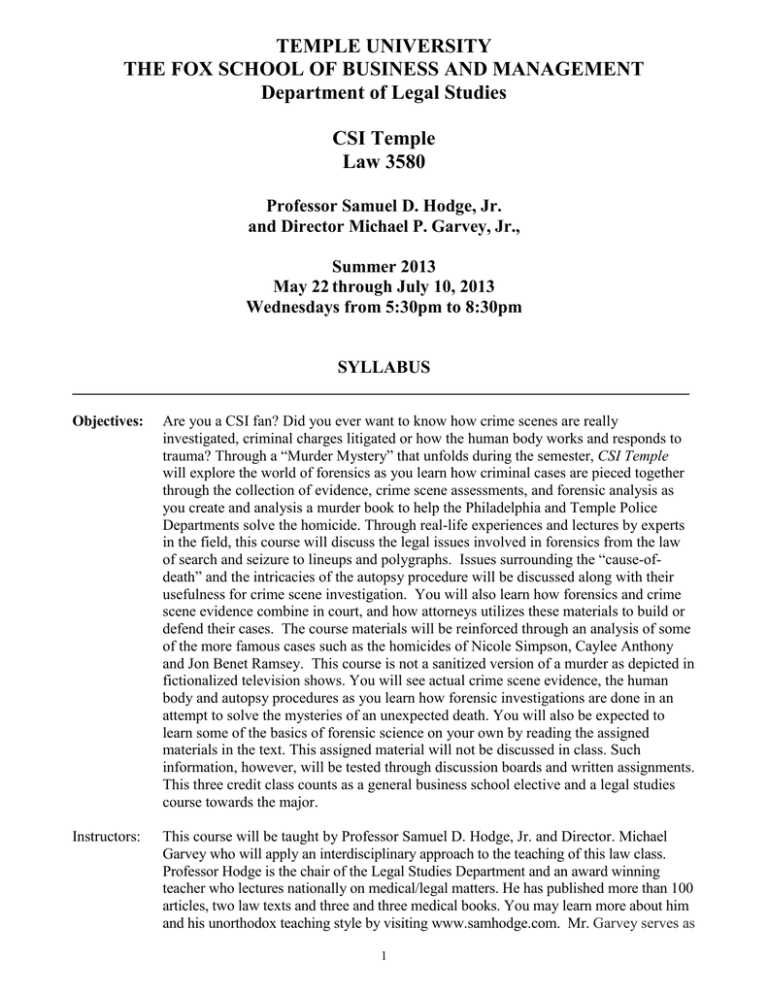
TEMPLE UNIVERSITY
THE FOX SCHOOL OF BUSINESS AND MANAGEMENT
Department of Legal Studies
CSI Temple
Law 3580
Professor Samuel D. Hodge, Jr.
and Director Michael P. Garvey, Jr.,
Summer 2013
May 22 through July 10, 2013
Wednesdays from 5:30pm to 8:30pm
SYLLABUS
________________________________________________________________________________
Objectives:
Are you a CSI fan? Did you ever want to know how crime scenes are really
investigated, criminal charges litigated or how the human body works and responds to
trauma? Through a “Murder Mystery” that unfolds during the semester, CSI Temple
will explore the world of forensics as you learn how criminal cases are pieced together
through the collection of evidence, crime scene assessments, and forensic analysis as
you create and analysis a murder book to help the Philadelphia and Temple Police
Departments solve the homicide. Through real-life experiences and lectures by experts
in the field, this course will discuss the legal issues involved in forensics from the law
of search and seizure to lineups and polygraphs. Issues surrounding the “cause-ofdeath” and the intricacies of the autopsy procedure will be discussed along with their
usefulness for crime scene investigation. You will also learn how forensics and crime
scene evidence combine in court, and how attorneys utilizes these materials to build or
defend their cases. The course materials will be reinforced through an analysis of some
of the more famous cases such as the homicides of Nicole Simpson, Caylee Anthony
and Jon Benet Ramsey. This course is not a sanitized version of a murder as depicted in
fictionalized television shows. You will see actual crime scene evidence, the human
body and autopsy procedures as you learn how forensic investigations are done in an
attempt to solve the mysteries of an unexpected death. You will also be expected to
learn some of the basics of forensic science on your own by reading the assigned
materials in the text. This assigned material will not be discussed in class. Such
information, however, will be tested through discussion boards and written assignments.
This three credit class counts as a general business school elective and a legal studies
course towards the major.
Instructors:
This course will be taught by Professor Samuel D. Hodge, Jr. and Director. Michael
Garvey who will apply an interdisciplinary approach to the teaching of this law class.
Professor Hodge is the chair of the Legal Studies Department and an award winning
teacher who lectures nationally on medical/legal matters. He has published more than 100
articles, two law texts and three and three medical books. You may learn more about him
and his unorthodox teaching style by visiting www.samhodge.com. Mr. Garvey serves as
1
the Director of the Office of Forensic Science for the Philadelphia Police Department
(PPD) and is a Deputy Managing Director for the City of Philadelphia. In these roles,
he is responsible for a nationally accredited full-service forensic laboratory, providing
oversight to all PPD forensic operations, maintaining national quality standards, and
advancing the City’s forensic capabilities. Prior to joining the PPD, Director Garvey
served with both the FBI and CIA for approximately fifteen years, working criminal,
counterterrorism, counter-proliferation and other intelligence operation cases around the
world.
Book:
Richard Saferstein, Criminalistics: An Introduction to Forensic Science, Tenth Edition,
Pearson/Prentice Hall. You will also be assigned a series of articles to read on forensics
that will be posted in Blackboard.
Course Outline
1.
Class One - May 22, 2013
An Introduction to the World of Forensics
a.
Topics
i.
An overview of criminal investigations
ii.
What is Forensic Science
iii.
An evolving definition of forensic science
iv.
The Locard Exchange Principle
v.
The Role of the Forensic Scientist
vi.
Types of Forensic Science
vii. Eyewitness identification
viii. Lineups
ix.
Chain of Custody from the Scene to the Courtroom
x.
Quality Assurance and Quality Control
a. National Standards
b. Examples of both positive and negative cases impacted by the presence
or absence of a robust QA/QC system based on scientific integrity
xi.
Murder of Amanda Christopher
b.
Exercise: Eyewitness and Lineup Procedures
c.
Read: Chapter One of the book.
d.
Discussion Board #1 due the Tuesday before our next class.
e.
Assignment #1 is due at the start of the class. This assignment will be posted on
blackboard one week before the start of class.
e.
Learn on Your Own - Read the following materials:
i.
An overview of the law of homicide
Read the articles that can be found at (pdfs of these materials can also be
found on BlackBoard and on the CSI website:
http://www.hg.org/murder.html
http://faculty.ncwc.edu/mstevens/293/293lect07.htm
http://definitions.uslegal.com/c/criminal-homicide/
http://voices.yahoo.com/homicide-vs-murder-differences95749.html
http://criminal.findlaw.com/criminal-charges/homicide-definition.html
2
ii.
iii.
iv.
v.
2.
Expert testimony – Daubert and Frye
Go to the Internet and research the differences between the Frye and
Daubert standards for expert testimony.
Ethics in Forensic Science
Read the article that can be found at:
http://www.evidencemagazine.com/index.php?option=com_content&task=
view&id=453
The Law of Search and Seizure – Fourth Amendment
Read the articles that can be found at:
http://faculty.ncwc.edu/mstevens/410/410lect14.htm;
http://www.nolo.com/legal-encyclopedia/search-warrant-basics-29742.html
http://www.nolo.com/legal-encyclopedia/search-seizure-criminal-law30183.html
http://criminal.findlaw.com/criminal-rights/search-and-seizure-and-thefourth-amendment.html
Eyewitness Identification
This material is contained in blackboard under the tab, “Eyewitness
Identification.”
Class Two - May 29, 2013
Human Anatomy
a
Topics
i.
An Overview of Anatomy
ii.
Anatomical Terms
iii.
The Systems of the Body
iv.
Murder of Amanda Christopher - developments
b.
Read: The materials on anatomy posted in Blackboard.
c.
Assignment #2 is due at the beginning of class.
d.
Discussion Board #2 due the Tuesday before our next class.
e.
Murder of Amanda Christopher – developments
f.
Speakers: Hector Lopez, M.D., Ph.D.
Dr. Lopez is a professor at Cooper Medical School in New Jersey and in charge of
their Human Anatomy and Pathology Lab. After you put on the surgical gloves
and anatomic aprons, he will show you the human body. These specimens will be
from people with real diseases so expect the unexpected.
g.
Learn on Your Own
i.
Read the materials on Blackboard under “Autopsy.”
a.
Establishing Death
b.
The Forensic Autopsy
c.
Post-Mortem Interval
d.
Identification of the Body
e.
The Body Farm – Go to You Tube and view stories about the Body
Farm
3
3.
Class Three - June 5, 2013
The Crime Scene
a.
Topics
i.
The role of crime scene investigation
ii.
Crime Scene Processing and Assessment
iii.
Primary v. Secondary Crime Scenes
i.
The Jon Benet Ramsey Crime Scene – What Went Wrong
v.
Securing and Isolating the Crime Scene
iv.
Crime Scene Recording
vii.
How to Search for Evidence
viii.
The Mobile Crime Lab
ix.
Use of Models, Photographs, Displays and Animations to Explain the Crime
Scene
x.
Crime Scene Reconstruction
a. Blood Stain Pattern Analysis
xi.
Murder of Amanda Christopher - developments
b.
Activity: Tour a crime scene response vehicle from the Philadelphia Police
Department’s Crime Scene Unit.
c.
Exercise: BSPA – determination of angle of impact
d.
Speaker: Marvin Burton, Commanding Officer of CSU
Lt. Marvin Burton is with the Philadelphia Police Department.
e.
Read: Chapter Two and Twelve of the text
f.
Assignment #3 is due at the beginning of class
g.
Discussion Board #3 due the Tuesday before our next class.
h.
Learn on Your Own - Read the following materials:
i.
ii.
iii.
4.
How to Properly Package the Evidence
http://www.crime-scene-investigator.net/collect.html
http://www.crime-scene-investigator.net/Phys_Evid_Manual_OR.pdf
http://www.forensicmag.com/article/dna-collection-and-packaging
Read the materials on the death of Michael Jackson.
http://www.today.com/id/32542682/ns/today-#.UX5v35UYJUQ
Go to You Tube and look at the stories about how it what determined
Michael Jackson’s death was a homicide.
http://www.autopsyfiles.org/reports/Celebs/jackson,%20michael_report.pdf
The Crime Scene
This material is contained in blackboard under the tab, “Crime Scene.”
Class Four - June 12, 2013
Physical and Trace Evidence and the Forensic Lab
4
Please note that we will be meeting in Room 132, South West Corridor of the Bio-Life
building for this class
a.
Topics
i.
The Forensic Lab
ii.
General Principles
iii.
Departments in the Lab
iv.
Government Lab v. Private Lab
v.
Physical & Trace Evidence
vi.
Types of Physical Evidence
vii.
Significance of Physical Evidence
a. Identification and Comparison of Evidence
b. Hair
c. Fibers
d. Paint
e. Soil, pollen, debris
f. Trace chemicals
g. Databases
b.
Read for class: Chapters 3, 5, 6, and 13
c.
In-class exercise: Microscope exercise
d.
Assignment #4 is due at the beginning of the class.
e.
Discussion Board #4 due the Tuesday before our next class.
f.
Learn on Your Own
i.
5.
Read Chapter 7 and the materials related to microscopy
a.
Microscopy
b.
Macroscopy
c.
Light microscopy
d.
Phase contrast microscopy
e.
Scanning electron microscopy
f.
Comparison microscopy/macroscopy
Class Five – June 19, 2013
Forensic Toxicology
a.
Topics:
i.
Understanding Poisons
ii.
Looking for Toxins
iii.
Collecting Samples
iv.
The Testing Procedure
v.
Interpreting Results
vi.
Understanding Alcohol
vii.
Depressants
viii. Stimulants
ix.
Date Rape Drugs
x.
Law, Evidence and Procedures for Forensic Scientists
5
xi.
6.
Murder of Amanda Christopher – developments
B.
Speaker: Edward Dugan
Mr. Dugan is a Forensic Chemist and the Forensic Laboratory Manager at the
Criminalistics Unit at City of Philadelphia’s Police Department Office of Forensic
Science.
C.
Reading: Chapter Nine
D.
Assignment #6 is due at the beginning of the class.
E.
Discussion Board #6 due is due Tuesday before our next class.
F.
Your term paper is due at the start of this class.
Class Six – June 26, 2013
The Forensic Lab: Forensic Chemistry and Toxicology
a.
Topics
i.
ii.
iii.
iv.
v.
vi.
General Principles
Organic Analysis
Inorganic analysis
Illegal Drugs – Cocaine to Cannabis
Designer Drugs – How They Try to Avoid Existing Drug Laws
a.
Composition
b.
Risks and Concerns
c.
Legal Issues
Murder of Amanda Christopher – developments
b.
Speakers: Heather Harris, MFS, JD
Ms. Harris is both an attorney and forensic chemist. She is a member of the
American Board of Criminalistics and has served as an expert witness on multiple
occasions.
c.
Exercise: NARC-LAB
d.
Read: Chapters Seven, Eight and Thirteen
e.
Assignment #5 is due at the beginning of the class.
f.
Discussion Board #5 due the Tuesday before our next class.
g.
Learn on Your Own - Read the following materials:
i.
Designer Drugs
http://www.livestrong.com/article/227581-what-are-the-different-types-ofdesigner-drugs/
http://www.lakeviewhealth.com/dangers-of-designer-drugs-bath-salts-andresearch-chemicals.php
http://www.drugfree.org/drug-guide/bath-salts
6
7.
Class Seven – July 3, 2013
Forensic Serology and DNA Analyses
a.
Topics
a.
Forensic Serology
b.
Nature of blood
i. Presumptive and confirmatory testing
ii. Serological characterization
a.
Blood stain patterns
b.
Semen
i. Presumptive and confirmatory testing
ii. Sexual Assault Evidence Collection Kit
c.
DNA Analyses
i.
Basic genetics and function of DNA
ii.
History of forensic DNA testing
iii.
STR analysis
iv.
Y-STR analysis
v.
Mitochondrial DNA analysis
vi.
Kinship Analysis
vii.
Statistics – the “so what” of the conclusion
viii. Future trends and technologies
xi.
CODIS
b.
Exercise: Presumptive blood testing and ABO characterization
c.
Exercise: DNA Typing - paper based exercise. Dr. Garvey will provide STR
profiles for basic interpretation and comparison
d.
Read: Chapter Ten
e.
Assignment #7 – is due at the beginning of class.
f.
Discussion Board #7 due the Tuesday before our next class.
j,
Learn on Your Own
i.
13.
Read the materials on Blackboard under “Serology.”
Class Eight – July 10, 2013
Forensic Pattern Evidence, Firearms, and Polygraph
a.
Topics
i.
Questioned Document Examinations
a.
Handwriting
b.
Forged documents
c.
Identification cards
d.
Comparative analysis
ii.
Latent Fingerprint Examinations
a.
Fundamentals of fingerprints
b.
Classification of fingerprints
7
c.
d.
iii.
iv.
Collection of reference prints
Collection of latent prints
1.
Development of latent prints
2.
AFIS
Firearms and Tool Mark Examination
a. Types of firearms
b. Trends in crime
c. IBIS
Polygraph Examination: Getting to the Truth
b.
Speakers: Ms. Jessica Rose Freda
Ms. Freda is an American Polygraph Association (APA) school trained Polygraph
Examiner. She is also a member of the American Polygraph Association and the
British European Polygraph Association.
c.
Exercise / Activity:
i.
Collecting known exemplars/reference fingerprints
ii.
Developing and collecting latent fingerprints
iii.
Conducting a Polygraph Exam
d.
Read: Chapters Sixteen and Seventeen
e.
Assignment #8 is due at the beginning of class
f.
Discussion Board #8 due before Tuesday, July16th at 8:00pm.
f.
Class wrap up and solving of the murder of Amanda Christopher.
g.
Learn on Your Own
i.
Read the materials on Blackboard under “Polygraph.”
COURSE REQUIREMENTS
1.
GRADING
ASSIGNMENT
A.
POINT VALUE
8 Written Assignments
64
Research Paper
25
Discussion Board Posts
11
TOTAL
100
Grading is based on a total point score of 100. There is a research paper worth 25 points,
eight written assignments that will provide an additional 64 points, and discussion posts
are worth 11 points.
8
2.
3.
B.
In the absence of an unforeseen emergency or prior written permission, a student who
misses an assignment deadline will receive an "F" for that assignment or a score of zero
(0) points.
C.
Your grade will consist of 8 written assignments that will be assigned each week. Each
assignment will have two separate questions and your answer is due no later than 5:30
p.m. on the day specified in the syllabus and is worth a total of eight (8) points. Missed
assignments may not be made up regardless of the reason. Each question shall be
answered with a two (2) page answer. In other words, your response shall be four pages
long.
D.
Twenty-five (25) points of your grade will be based upon a research paper that will be
assigned to you at the beginning of the semester. This paper is to be at least 5 pages in
length, typed, double spaced with one inch margins and the font must be Times New
Roman 12. Your paper must cite to at least five (5) references. Students shall be
penalized one (1) point for every calendar day the assignment is turned in past the
deadline which is June 26, 2013.
E.
This class requires posting on a weekly discussion board for a total of eleven (11) points
(1.5 points per response). Discussion board topics will be posted on Thursdays of each
week, and responses are due NO LATER THAN Tuesday at 8:00 pm. Missed
discussion boards may not be made up regardless of the reason.
F.
Class participation. In class participation is both encouraged and rewarded. We keep
track of when an individual contributes to the class discussion. At the end of the
semester, students who have made exceptional contributions will receive a half-step
“participation bump” in their grades. For example, if your contribution is considered
exceptional and your points corresponding to a B grade, we will bump you up to a B+.
Please note that this bump for participation is discretionary for which we are the sole
judges and will be awarded to only those students who make exemplary contributions.
When you answer a question in class, please state your name so we can record your
participation.
ACADEMIC HONESTY
A.
All answers must be your own work product. Under no circumstance are you to copy
another student’s answer. In other words, these assignments are to be treated like an inclass examination. A violation of this rule can result in the appropriate disciplinary
sanctions including charges being brought before the University Disciplinary Counsel.
Please note that we have use of computer software that can check for duplicate answers
among class members and papers from the Internet.
B.
Under no circumstance are you to use the clicker of another student for any purpose
including registering attendance or answering an in class quiz. Such a use will be
considered a violation of the Honor Code and will result in Disciplinary Proceedings.
ATTENDANCE
Attendance is considered mandatory especially since there are only eight classes.
4.
CLASS PARTICIPATION
9
Classroom participation is strongly encouraged. For those who I determine have outstanding
class participation, your final grade will be bumped up one half letter grade. When you
participate, you should state your name so I can keep track of your participation and give you
credit.
5.
6.
QUESTIONS ABOUT THE CLASS
A.
Questions concerning the course, grading and other academic issues are to be discussed
with Nicole Saitta.
B.
Phone messages may be left for the Lecturer, Nicole Saitta, by e-mailing her.
C.
Ms. Saitta will hold one hour of virtual office hours each Monday night from 8 to 9 p.m.
TIME OF CLASS
Classes start promptly at 5:30pm and will end promptly at 8:30pm. We will have a short break in
the middle of the session.
7.
8.
PROHIBITION AGAINST CHANGING A GRADE
A.
University and College policies prohibit the changing of a grade after the grade sheets
have been turned into the Registrar.
B.
If you are disappointed with your score, please do not ask that your grade be reconsidered
or request permission to do an extra-credit project. We are prohibited from
accommodating these requests.
TEMPLE’S POLICY ON STUDENTS AND FACULTY ACADEMIC RIGHTS AND
RESPONSIBILITIES:
A.
9.
10.
Freedom to teach and freedom to learn are inseparable facets of academic freedom. The
University has adopted a policy on Student and Faculty Academic Rights and
Responsibilities (Policy #03.70.02), which can be accessed through the following link:
http://policies.temple.edu/getdoc.asp?policy_no=03.70.02.
DISABILITY
A.
Any student who has a need for accommodation based on the impact of a disability
should contact me privately to discuss the specific situation as soon as possible.
B.
You may also contact Disability Resources and Services at 215-204-1289 in Ritter Annex
to coordinate reasonable accommodations for a student with a documented disability.
CONTACT INFORMATION
A.
Professor:
Samuel D. Hodge, Jr.
Professor and Chair
Department of Legal Studies
Alter Hall - Room 464
B.
Lecturer:
Nicole Saitta
10
Alter Hall - Room 406B
C.
Telephone Numbers:
(215) 204-1629 (Administrative Assistant)
(215) 204-8135 (Samuel D. Hodge, Jr., Chair)
D.
E-Mail Addresses:
Professor Samuel Hodge, Jr. – temple885@aol.com
Director Michael Garvey - Michael.Garvey@phila.gov
Nicole Saitta – tud33378@temple.edu
4/28/13
11



